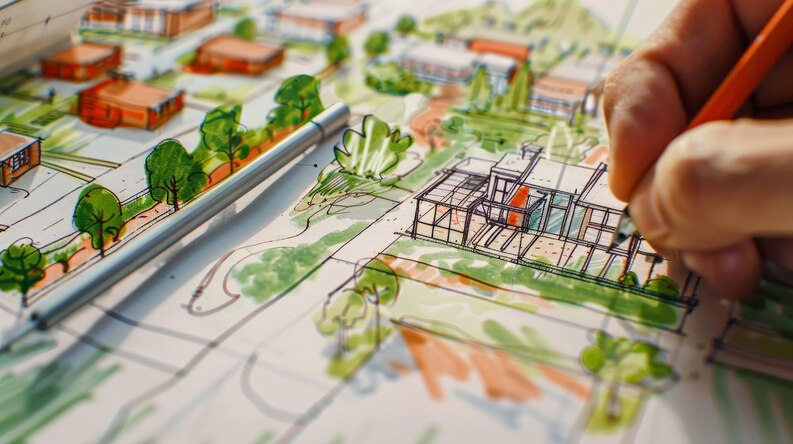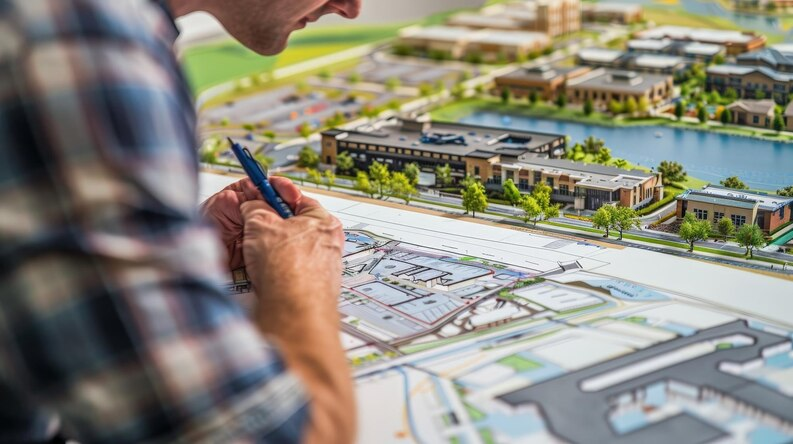
Subdivision planning is the strategic process of dividing a large parcel of land into smaller lots to create residential, commercial, or mixed-use developments. This process plays a critical role in shaping urban and suburban landscapes, providing the framework for organized growth and community development. Effective subdivision planning requires careful consideration of various factors, including land use regulations, infrastructure requirements, environmental sustainability, and community needs. Planners must balance maximizing land utility with preserving natural resources and enhancing the quality of life for future residents. A comprehensive subdivision plan outlines the layout of streets, open spaces, utility networks, and public amenities, ensuring that the development integrates seamlessly into its surrounding environment. It serves as a blueprint that guides the entire project lifecycle, from feasibility studies and design to regulatory approvals and construction.
The success of a subdivision project depends on aligning the development's objectives with regulatory standards and community expectations. Modern subdivision planning increasingly prioritizes sustainability, inclusivity, and smart infrastructure. This shift involves incorporating green spaces, renewable energy systems, and pedestrian-friendly designs to create vibrant, livable neighborhoods. Collaboration among developers, urban planners, local authorities, and community stakeholders is essential to address diverse interests and challenges. Thorough site analysis, proactive community engagement, and adherence to environmental regulations are vital to mitigating risks and promoting long-term value. As cities continue to expand, subdivision planning must embrace innovative solutions to accommodate growing populations while fostering sustainable and resilient communities.

Key Considerations in Subdivision Planning
Effective subdivision planning hinges on a comprehensive understanding of various key considerations that shape the project's success. From regulatory compliance to environmental sustainability, each factor plays a critical role in ensuring the development meets community needs while preserving natural resources. Planners must carefully assess land use regulations, infrastructure requirements, and environmental impacts to create functional, livable spaces. Additionally, integrating amenities that enhance quality of life fosters vibrant communities. Addressing these elements early in the planning process establishes a solid foundation for sustainable and efficient development.
Land Use and Zoning Regulations
Land use and zoning regulations dictate how land can be used and developed within a specific area, ensuring orderly growth and the compatibility of different land uses. These regulations typically classify land into zones such as residential, commercial, industrial, and agricultural, each with designated permitted uses and development standards. Zoning laws may govern aspects like building height, lot size, setbacks, and density to promote safety, environmental protection, and community aesthetics. Compliance with zoning regulations helps maintain a balance between development and preservation, supporting sustainable urban planning and enhancing the quality of life for residents.
Environmental Impact Assessments
Environmental Impact Assessments (EIAs) are essential processes used to evaluate the potential environmental consequences of proposed projects before they are carried out. They help identify, predict, and mitigate adverse environmental effects, ensuring that development is conducted in an environmentally responsible manner. EIAs consider various factors, such as air and water quality, biodiversity, soil erosion, noise pollution, and socio-economic impacts. By involving public consultation and expert analysis, EIAs promote transparency and informed decision-making. This process ultimately helps balance economic development with environmental protection, fostering sustainable growth.
Infrastructure and Utilities Planning
Infrastructure and utilities planning is a critical component in the development of sustainable and efficient communities. It involves the strategic design and coordination of essential services such as water supply, electricity, sewage systems, transportation networks, and telecommunications. Proper planning ensures that these utilities are reliable, cost-effective, and capable of meeting the current and future demands of the population. Additionally, incorporating environmentally friendly technologies, such as renewable energy sources and smart grid systems, enhances sustainability and reduces the environmental impact. Effective infrastructure planning also requires collaboration between government agencies, private stakeholders, and the community to ensure seamless service delivery and long-term growth.
Community Needs and Amenities
Modern subdivisions prioritize livability by integrating parks, schools, shopping centers, healthcare facilities, and recreational spaces. Planners must assess demographic trends to provide amenities that meet the needs of residents, enhancing the quality of life.

Subdivision Planning Process
The subdivision planning process involves a systematic sequence of steps that transform raw land into a functional and well-organized community. This process requires careful coordination between developers, urban planners, engineers, and regulatory authorities to ensure that the project meets both legal requirements and community needs. From initial feasibility assessments to final implementation, each phase plays a critical role in creating a sustainable, efficient, and livable development. Proper execution of the subdivision planning process not only enhances property value but also contributes to the long-term social, economic, and environmental well-being of the community.
This phase evaluates the site's suitability for development by analyzing topography, soil conditions, environmental constraints, and market demand. Economic viability is also assessed to determine the project's profitability.
Conceptual Design and Master Planning
A conceptual layout is created, outlining lot divisions, road networks, green spaces, and infrastructure placement. Master planning ensures the efficient use of land while considering future expansion and sustainability.
Regulatory Approvals
Developers must obtain approvals from various government agencies, including zoning boards, environmental protection agencies, and local municipalities. This process involves submitting detailed project plans for review and compliance verification.
Detailed Engineering Design
Once approvals are secured, engineers develop detailed designs for roads, drainage systems, utility networks, and public spaces. This stage involves rigorous planning to ensure safety, efficiency, and long-term functionality.
Construction and Implementation
With all plans in place, construction begins. Project management strategies ensure timely completion, adherence to budget constraints, and compliance with quality standards. Regular inspections and adjustments help address unforeseen challenges.

Legal and Regulatory Framework
Navigating the legal and regulatory framework is a critical component of subdivision planning, ensuring that developments align with local policies, land use regulations, and environmental standards. Compliance with these regulations not only legitimizes the project but also safeguards the interests of both developers and the community. Understanding the intricate requirements of permits, zoning laws, land ownership documentation, and environmental guidelines is essential to avoid legal disputes, project delays, and financial penalties. A thorough grasp of the regulatory landscape enables developers to streamline the approval process and maintain transparency throughout the project lifecycle.
Local Government Policies
Local governments establish policies guiding subdivision development. These policies cover zoning, infrastructure requirements, environmental protection, and land use planning, influencing project design and execution.
Permitting and Compliance Requirements
Developers must secure various permits, including land-use permits, environmental clearances, and building approvals. Non-compliance with regulations can lead to delays, legal disputes, and financial penalties.
Land Ownership and Title Documentation
Ensuring clear land ownership is critical before development begins. Title verification prevents legal disputes and guarantees rightful possession. Proper documentation streamlines the subdivision process and facilitates future transactions.

Design Principles in Subdivision Planning
Effective subdivision planning relies on thoughtful design principles that balance functionality, aesthetics, and sustainability. Well-designed subdivisions not only enhance the quality of life for residents but also contribute to long-term environmental and economic benefits. Incorporating sustainable practices, efficient transportation networks, and green spaces fosters vibrant, resilient communities. By prioritizing smart layouts and innovative infrastructure, planners can create developments that meet both present and future needs while promoting environmental stewardship and social cohesion.
Sustainable Development
Eco-friendly planning integrates energy-efficient infrastructure, waste management systems, and green spaces. Sustainable strategies minimize environmental impact while reducing long-term operational costs.
Traffic and Road Network Layout
Efficient road networks enhance accessibility and reduce congestion. Designing a hierarchy of roads—including main thoroughfares, secondary streets, and cul-de-sacs—improves traffic flow and pedestrian safety.
Green Spaces and Recreational Areas
Incorporating parks, gardens, and walking trails fosters community well-being. Green spaces contribute to environmental sustainability by improving air quality, supporting biodiversity, and reducing urban heat.
Water Management Systems
Proper drainage, rainwater harvesting, and wastewater treatment are crucial for sustainable development. Effective water management prevents flooding, conserves resources, and promotes environmental responsibility.

Challenges in Subdivision Planning
Subdivision planning involves navigating a range of challenges that can impact project feasibility, timelines, and overall success. These challenges stem from various factors, including physical land constraints, community concerns, financial limitations, and environmental considerations. Addressing these issues requires careful analysis, proactive engagement with stakeholders, and innovative solutions to balance development goals with sustainability and community well-being. By understanding and mitigating these obstacles, planners can create subdivisions that are both functional and harmonious with their surroundings.
Land Constraints
Limited land availability, especially in urban areas, can complicate planning. Planners must optimize land use through smart zoning and vertical expansion strategies to accommodate growing populations.
Community Opposition
Local residents may resist new developments due to concerns over congestion, environmental impact, and property value fluctuations. Transparent communication and community engagement help address these concerns and foster support.
Budget and Funding Limitations
Developers often face financial constraints due to high land acquisition costs, regulatory fees, and infrastructure expenses. Securing funding through public-private partnerships, grants, or investors can help overcome financial hurdles.
Climate Change and Environmental Protection
Extreme weather events, rising temperatures, and ecological degradation pose risks to subdivision projects. Climate-resilient planning includes flood control measures, green energy integration, and conservation efforts to mitigate these risks.

Case Studies and Best Practices
Analyzing case studies and best practices in subdivision planning provides valuable insights into what makes a development successful. By examining real-world examples, planners can identify effective strategies, common pitfalls, and innovative approaches that enhance both functionality and sustainability. These case studies highlight how thoughtful planning, community engagement, and adherence to environmental and regulatory standards contribute to creating livable, resilient communities. Understanding lessons from past projects helps developers refine their methods and adopt best practices for future developments.
Successful Subdivision Projects
Successful subdivision projects exemplify how thoughtful planning, innovative design, and strategic execution can transform land into thriving communities. These projects balance environmental sustainability, infrastructure efficiency, and community well-being, setting benchmarks for future developments. By analyzing standout examples, planners can gain valuable insights into best practices that enhance livability, promote sustainable growth, and address the evolving needs of modern society.
- Vauban, Germany – A model for sustainable living, this subdivision features car-free zones, renewable energy sources, and green infrastructure.
- Seaside, Florida, USA – Known for its walkability and community-centric design, Seaside exemplifies New Urbanism principles with mixed-use development and pedestrian-friendly streets.
Lessons Learned from Past Developments
Analyzing past subdivision developments provides valuable insights into best practices and common pitfalls. Each project presents unique challenges, offering lessons that can inform future planning processes. Successful developments often highlight the importance of early stakeholder engagement, comprehensive infrastructure planning, and sustainable design integration. By understanding these key takeaways, planners can enhance project efficiency, minimize risks, and create more resilient and community-oriented subdivisions.
- Infrastructure First – Delays in utility installation can disrupt project timelines. Prioritizing infrastructure ensures smooth development.
- Community Engagement Matters – Projects that incorporate public feedback face less opposition and higher acceptance rates.
- Sustainability Pays Off – Energy-efficient designs and green spaces increase property value and attract eco-conscious buyers.
Future Trends in Subdivision Planning
As urbanization accelerates and environmental concerns grow, the future of subdivision planning is shifting towards more sustainable, technologically advanced, and community-focused models. Innovative design approaches are reshaping how residential developments are conceptualized, prioritizing efficiency, environmental responsibility, and quality of life. These emerging trends aim to create resilient communities that not only accommodate population growth but also enhance social cohesion, promote green living, and integrate smart infrastructure. By adopting forward-thinking strategies, subdivision planning can meet the evolving needs of both present and future generations.
Smart Infrastructure Integration
The rise of smart cities influences subdivision design, incorporating IoT-enabled street lighting, real-time traffic monitoring, and automated waste management. These technologies enhance efficiency and sustainability.
Eco-friendly and Green Design Solutions
Developments are increasingly integrating solar panels, rainwater harvesting systems, and sustainable building materials. Green architecture minimizes environmental impact and promotes self-sufficiency.
Community-Oriented Developments
Modern subdivisions focus on fostering a sense of community through shared spaces, mixed-use developments, and walkable neighborhoods. Social connectivity and inclusivity are prioritized to improve residents' quality of life.
Subdivision planning is a multifaceted process that requires balancing regulatory, environmental, and community considerations. By adhering to sustainable practices, leveraging smart infrastructure, and addressing challenges proactively, planners can create thriving, resilient communities. Looking ahead, emerging trends such as green technology and smart urban planning will continue to shape the future of subdivision development.

Get a no-obligation offer in just a few minutes.





.webp)




.webp)
